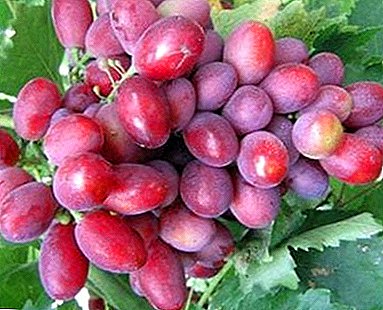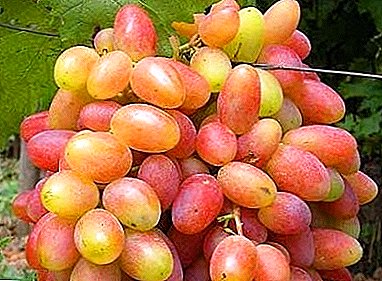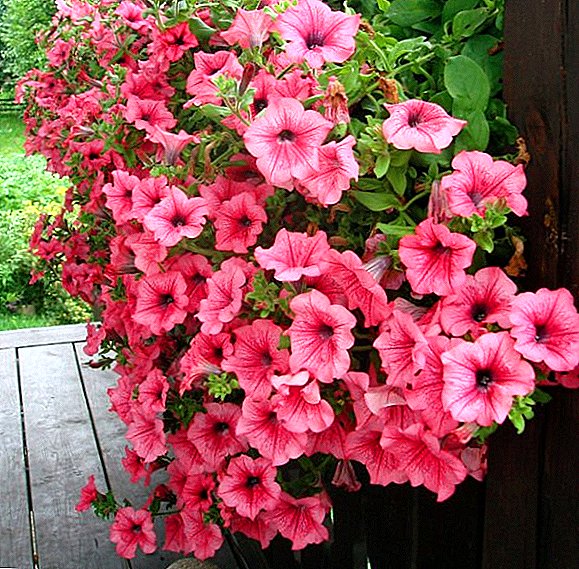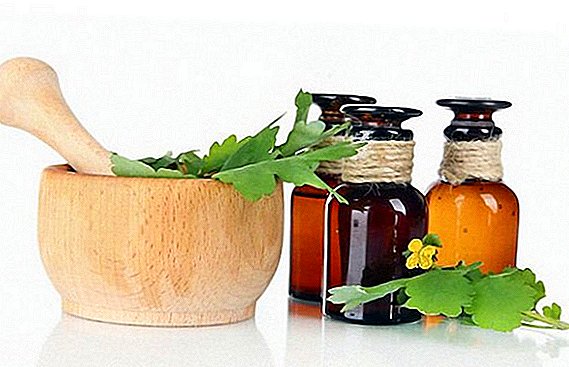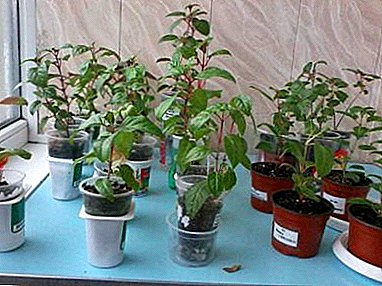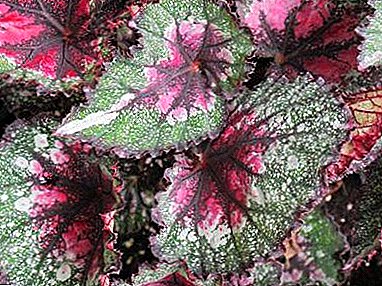
Tuberous begonia is one of the most beautiful begonias of this family, famous for being able to liven up even the darkest corners of the room and create a cozy atmosphere in the house.
Consider in the article, with what problems you can meet, growing a flower. Or rather, if buds or flowers began to fall off at the tuberous begonia, what to do if the leaves are curled and dry.
And also, for what reasons the plant does not dismiss buds or does not want to release them at all. In the photo you can see how the flower looks affected by pests or diseases.
Features
The color palette of tuberous begonia simply amazes with its dazzling and versatility, starting with creamy-white shades and ending with dark-purple combinations. The leaf of the begonia has an asymmetrical shape, covered with small hairs. The stem of the flower is juicy, watery, large size. This stem is designed to retain moisture in the plant and maintain massive leaves.
But, no matter how good-looking the flower is, he is not able to completely cover himself from the dangerous pests, encroaching on his colorful and "appetizing". Read below if you want to learn how to help your plant escape from unwanted parasites and diseases.
Propensity to disease
With good and proper care, tuberous begonia rarely turns white, especially if it grows indoors, but pests or infections can overtake the plant at any time, because we can put them on clothes or shoes. Let us consider how diseases and pests can manifest themselves, and how to fight them after that.
What to do if you notice the flowers fall off?
 First you need to understand what could serve this, because the reasons for this behavior of the plant are quite a lot. Here are a few of them:
First you need to understand what could serve this, because the reasons for this behavior of the plant are quite a lot. Here are a few of them:
- The flower is not very comfortable in this habitat (location or care that you provide him).
- Frequent movement of the flower from place to place.
- Diseases and pests.
If buds began to fall off in the tuberous begonia, then first of all it is worth changing the conditions of its maintenance. Change the watering schedule and monitor the air temperature. In winter, you should completely eliminate watering of this species, because the plant at this time hibernates (how to properly maintain the tuberous begonia in the winter, read here). In summer, the flower requires abundant watering, but do not form stagnant water, this can lead to a host of other consequences.
The most comfortable temperature for the tuberous begonias: 20-23 degrees - in the summer, 16-18 degrees - in the winter. If the temperature is below normal, the buds of the plant start falling off.
The flower does not like direct hits of the sun, so it is best to find the place where the lighting is diffused. The right decision would be to locate the plant on the north side in order to avoid burns from the scorching sun. If the tuberous begonia weakens (rare leaves and a small number of buds), then you need to make mineral fertilizers.
Attention! Avoid nitrogen fertilizers that severely inhibit the formation of buds.
If the flower buds fall, perhaps the plant appeared pests. The most common are:
- Mealy dew. Young shoots and stems appear dark brown balls or gray-white bloom, similar to mold.
This infection appears because of the abundant watering and stagnation of water, so to save the flower is to reduce watering and clean the infected areas.
- Bacterial spotting. On the back of the sheet, small watery spots appear, similar in appearance to pieces of glass.
- Ring spots. Green-yellow spots and concentric lines are visible on the leaves of the flower. All this can transform into spots of golden brown and death.
When the ring and bacterial blotch affected plants are completely destroyed, so that infection does not pass to other flowers and could not harm them. After which the earth is thoroughly disinfected.
- Red spider mite and aphid. In this case, the tuberous begonia can only help treatment with special preparations.
Buds fall
 The reason for the fall of the buds in the tuberous begonia may be approximately the same as when the flowers themselves fall:
The reason for the fall of the buds in the tuberous begonia may be approximately the same as when the flowers themselves fall:
- Inappropriate microclimate. If the conditions of detention are wrong, then you should pay attention to it. In its natural habitat, the flower is used to be in wet places - tropical forests, subtropics, and home air is too dry for this plant.
To avoid such an incident and rejoice in bloom all year round, the tuberous begonia should be systematically moistened.
- Mineral deficiency. Tuberous begonia grows rapidly and may soon lack nutrients.
If you do not want your plant to suffer from such a shortage, then, for starters, it is worthwhile to select a reference soil for this type of plant. This is a mixture consisting of equal parts of coniferous, leaf and sod land with the addition of peat and sand. This environment will contribute to good flowering. The complex of mineral fertilizers, such as Kemira Lux, will also help us to correct the situation.
Important! It is best to make such procedures with gloves. - Defeat parasites and diseases. The most common with these symptoms are gray rot and powdery mildew.
Prevent this process will help timely processing of begonias Bordeaux mixture (copper-containing fungicide) or a solution consisting of soap (20g), blue vitriol (2g), dissolved in 1 liter of water. Progressive disease is best sprayed with a 1% solution of "Fundazol."
What are the leaves curled from and how to proceed in this case?
The leaves of the tuberous begonias can curl under the influence of many factors that can be detected in time, and then subsequently eliminated.
- Watering. Leaves are curled only when there is a lack of moisture; this is due to the high sensitivity of the tuberous begonia to air humidity. To monitor the level of moisture is to place a container with flowers in a vessel with wet expanded clay.
- Nutrition. To avoid such unpleasant situations, it is sufficient simply to feed twice a year with a ready-made complex or potassium nitrate.
- Pot. When you first transplant, you can not plant begonia in too large a pot. The ideal size for adult tuberous begonias is from 8 to 10 centimeters. The best pot will be the product of ceramics.
- Diseases and pests. The most common disease is "Mealy dew". The main problem is its stealth. First, a white bloom forms on the leaves, which soon hardens and causes the leaf to dry, causing it to curl.
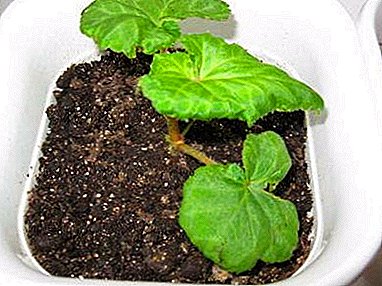 The soil. The cause of leaf curling associated with the soil can be excited by insufficient looseness. Another reason may be the wrong composition of the soil, caused by the absence of any element, or a violation of mixing technology.
The soil. The cause of leaf curling associated with the soil can be excited by insufficient looseness. Another reason may be the wrong composition of the soil, caused by the absence of any element, or a violation of mixing technology.
If you find a change in the shape of the leaves in the tuberous begonia should not panic. You need to plan your actions and start fighting with it.
First you need to recognize the cause, it will help us in determining the means of struggle. For example, pest infestation should use insecticides, and in the case of an unsuitable pot, replace it. In principle, these are all the most important actions for you.
What to do if the leaves dry?
One of the characteristic features of improper care can be a dramatic change in conditions (how to properly care for tuberous begonia at home and in the open field, read here, and from this article you will learn about the features of growing ampelous plant species). A flower can be very stressful if moved from one place to another. If you still moved it and began to notice the appearance of dry leaves, it is better to return the plant to its original place, or where there is sufficient lighting and the absence of drafts.
If the plant leaves dry in winter, then such a reason may be its high sensitivity to dry air. Therefore, in winter, tuberous begonia is best located away from heating devices or daily spray, do not let the leaves dry out.
Why doesn't the plant bloom or stop blooming?
The ability to bloom does not always depend on the plant variety, a lot depends on the correct care (you can learn about the features of planting and growing begonias in the Bolivian house and on the plot here, and from this article you will learn about ampelous begonia and how to look after it). At this point we consider the reasons why the tuberous begonia does not dissolve, and what to do to avoid this problem.
- One of the reasons may be the age of the plant. Begonias can only fully bloom if there are at least five rings on the stems. If you bought a young plant, then most likely the flowering will not be long and will be able to please you with its flowering next time no sooner than it fully matured.
- Lack of sunlight. Good lighting affects not only the health of the flower, but also its abundant flowering. Arrange the tuberous begonia in a well-lit place in order to avoid such a problem.
Attention! It is worth considering that direct sunlight can burn the leaves and dermis. Shade the plant to avoid similar situations or choose the south-east and south-west sides.
- Air humidity. If the air is too dry, the plant will not only stop flowering, but also begin to dry out. You can prevent this by spraying or placing a decorative container with water next to the plant.
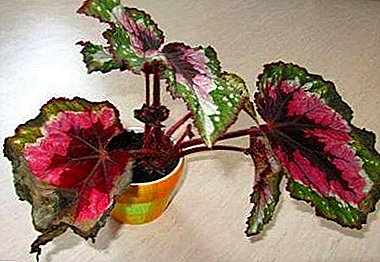 Temperature drops and drafts. How to make a heat-loving plant to bloom in conditions of sudden changes in temperature? It's impossible. Therefore, it is necessary to keep the tuberous begonia in comfortable conditions for it, avoiding constant drafts and temperature changes.
Temperature drops and drafts. How to make a heat-loving plant to bloom in conditions of sudden changes in temperature? It's impossible. Therefore, it is necessary to keep the tuberous begonia in comfortable conditions for it, avoiding constant drafts and temperature changes.- Excess fertilizer. A flower will not bloom if it has no place to take additional forces with a lack of useful substances in the soil. This situation can be solved by adding fertilizer to the soil.
Follow the instructions as excess fertilizer may not provoke an active growth of the outlet, but also lead to a massive burn of the roots.
- The presence of pests. In the warm season, as a rule, the tuberous begonia is carried out into the street. Therefore, the flower should be regularly inspected for the presence of various pests. Acaricides and insecticides will help you in the fight against such lesions. You may have to process the flower in several visits.
Other diseases and pests
Flower immunity may weaken for several reasons. At this time, he is vulnerable to all sorts of infections.
In many ways, the disease and the effectiveness of their treatment depend on the immunity of the plant. If it is watered and fed regularly, then it will be much easier to fight diseases, because the plant will have much more strength to withstand defeats.
Infectious diseases include:
- Bacterial spotting.
- Ring spots.
- Black root rot.
- Vascular bacteriosis.
Pest diseases:
- Shchitovka and false guard.
- Hothouse whitefly.
- Gallic and leaf nematodes.
- Red spider mite.
- Aphid greenhouse.
- Hothouse thrips.
A photo
Further on the photo you can see examples of the defeat of the tuberous begonia with various diseases and pests.




Prevention
To avoid unnecessary problems for us, simply follow the watering and temperature of the air for the plant, try to get rid of pests as soon as they appear and feed the flower.
During flowering, tuberous begonia should be fed at least once a week. complex mineral fertilizers, so that the plant does not lose its vitality, giving them to maintain flowering. It is recommended to cut off the faded leaves - then the color will be more saturated.
- tuber from cuttings;
- ampelnuyu their cuttings and seeds.
For a good grower, a plant is not just a decoration for a room or a garden, but also a true friend. A flower is the same pet as a cat or a dog that needs proper care. Timely watering, providing light, protection from pests - all this is very important. Only with proper care and expression of love will the flower please the eye and grow healthy.


 The soil. The cause of leaf curling associated with the soil can be excited by insufficient looseness. Another reason may be the wrong composition of the soil, caused by the absence of any element, or a violation of mixing technology.
The soil. The cause of leaf curling associated with the soil can be excited by insufficient looseness. Another reason may be the wrong composition of the soil, caused by the absence of any element, or a violation of mixing technology. Temperature drops and drafts. How to make a heat-loving plant to bloom in conditions of sudden changes in temperature? It's impossible. Therefore, it is necessary to keep the tuberous begonia in comfortable conditions for it, avoiding constant drafts and temperature changes.
Temperature drops and drafts. How to make a heat-loving plant to bloom in conditions of sudden changes in temperature? It's impossible. Therefore, it is necessary to keep the tuberous begonia in comfortable conditions for it, avoiding constant drafts and temperature changes.

